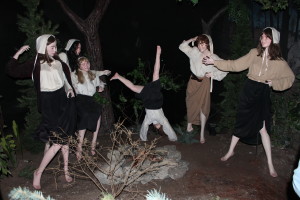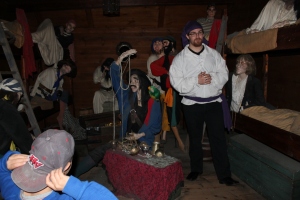I wonder what happened when officials stepped in from outside put a halt to the goings on in Salem. Think what it must have been like living there at this time. Actions have consequences. Salem ( a misnomer since the action really took place in a small town named Danvers and, later, Salem Village) was a small community. Those accused were friends, family and neighbors of their accusers. How could you forgive the ones who hanged one of your family members as a witch and terrorized the others? What kind of amends would be enough? Speaking for myself, I am not sure this is something I could ever forgive. I would guess that, despite the end of the witch hunts, this village remained troubled for years.
Some believe that the curses laid upon the accusers, the judges, and the ones who executed the alleged witches are in effect to this day. Giles Corey was pressed to death, the only one not hanged. He cursed all the Sheriffs to die before their time forever. Oddly enough, quite a few have died from various chest related illnesses.
Financial reparations were paid beginning in the early 1700s. Would this be enough to ease the grief? Many of those whose family members had been accused or hanged moved away to a new Village called Salem’s End. We can’t know what they are feeling but I would guess PTSD would be the least of it. How could one every trust anyone ever again? People on both sides: the accused and the accusers, changed their names. One of the hanging judges was a Hathorne; Nathaniel Hawthorne added the w. And the Nurse family, right in the thick of the storm, moved away and became Nourses.
And what about those who remained firm in their belief that the accusations had merit? That the hangings were valid?
Reverend Parris was one who continued to defend his actions, refusing to believe – or behave as though he believed – that he had been in the wrong. Right from the beginning he was a believer in the girls’ tales. He accepted the testimony of ‘spectral evidence’. He remained in his post in the village. (Can you imagine what Sunday morning in church must have been like? All the hard looks and muttered comments and the minister who had really supported the crisis sermonizing from the pulpit.) It must have been a nightmare.
Anyway, those who opposed Parris (and I would guess there would be many) tried to force him to leave. The battle went on for several years. Finally ministers and other important personages from Boston were called in to render an opinion. But it was not until 1696, four years later, that Parris finally stepped down.
Parrish had a very hard time finding another post. (Consequences, remember?) He finally ended up in a tiny town in western Mass, the frontier at that time and the target of regular Indian attacks. Salem had trouble finding a replacement. (Anyone surprised?) The village finally accepted a young man just out of school.
In the wider political world, the storm in Salem adversely affected the futures of both Cotton and Increase Mather, destroying their influence. Admittedly, I am not as conversant with the politics of that time as perhaps I could be but in my view there was some duplicity in Cotton Mather’s behavior during the witch trials. In any event, the witch trials and all the consequences stemming from them destroyed the hold of Puritanism on New England and the developing country.









